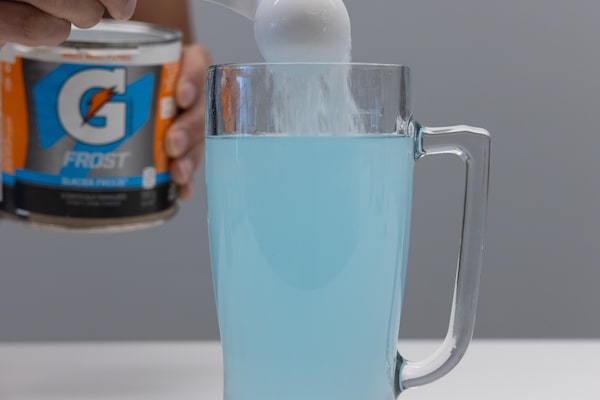
Tipping a scoop of Gatorade drink powder into a glass of water on August 10, 2023.Patrick Dell/The Globe and Mail
I’m a regular buyer of powdered Gatorade sports drink, and I have suffered much. Last year, I saw a can at Walmart go to $6 from $5. This year that can is $7.50.
But it’s not just the price that changed. In July, I noticed something different with the can. The mixing instructions now say one can of powder yields only seven litres of Gatorade, compared with eight previously.
The curious thing is that the total amount of powder in the can has not changed. Apparently, the same 560 grams of Gatorade powder now yields one whole litre less drink.
How, by all the laws of gods and Newtonian physics, is this even possible?
I set out to do some serious investigative journalism, delving deep into this unyieldingly critical issue of our time.
I say that only half in jest. You might have heard of “greedflation.” According to the theory, companies took advantage of whatever sparked the current bout of inflation and raised prices as much as they could – definitely more than required – and ended up causing more inflation. And now that the initial factors of inflation seem to be waning, prices aren’t coming back down.
Canada’s major grocers have the ability to lay ‘greedflation’ charges to rest – but decline to do so
This idea was notably raised in a paper this year by the economist Isabella Weber, who calls the phenomenon “sellers’ inflation.” One example she cites is PepsiCo Inc. PEP-Q, the company behind Gatorade.
In earnings calls, PepsiCo management no longer talk as much as before about higher costs forcing them to raise prices. Rather, the company covets higher prices because it wants to – and because it can. Chief executive officer Ramon Laguarta says PepsiCo is “trying to create brands that can stand for a higher value, and consumers are willing to pay more for our brands.”
This can of seven-litre Gatorade (”glacier frost” flavour) is a microcosm. My intrepid reportage led me not just to PepsiCo but also Walmart Inc. WMT-N, the company that sold me the powdered drink, and the Competition Bureau, which in part deals with consumer protection.
In the end I was left in utter befuddlement at a stark reality: There’s probably subtler forms of price hikes lurking that you don’t notice, and you really can’t do anything about it.
First off, the key questions that the shrinking can of Gatorade raises:
Was the 50-per-cent increase in price over two years not enough, and Gatorade had to go further and change the powder to a different, lower-quality one?
Or has Gatorade quietly reduced its powder and then added filler to stretch its product, so that it can pretend it is not engaging in the “shrinkflation” phenomenon that has become so prevalent in this economy?
Well, no, it’s not a different powder. It’s exactly the same, according to PepsiCo.
Spokeswoman Melanie O’Sullivan told me the company had “refreshed” the packaging, conducted “a review of the full nutritional facts” and changed the serving size to “to better deliver the optimal levels of functional ingredients.”
That’s why the same Gatorade can now yields one litre less in drink, Ms. O’Sullivan said. The reduction “has nothing to do with inflation.” Rather, the serving size was simply “optimized.”
I guess that is a true statement. When the same can of powder makes seven litres of Gatorade instead of eight, the resulting drink is more concentrated, stronger. It is therefore “optimized.” But here is another true statement: You’d also use up the can faster.
Sylvain Charlebois, a professor of food distribution and policy and the director of the Agri-Food Analytics Lab at Dalhousie University, said Gatorade’s move is common.
“Many either shrinkflate their major product or advise consumers to use more of it, and that appears to be the case with Gatorade,” he said. “Shrinkflation – but instead it’s more like usage-flation.”
Shrinkflation deals a surprise ice cream tax to consumers
Then there is the matter of how the Gatorade can was advertised.
I always buy powder online from Walmart. The product listing does not specify how many litres you can make, but it does include a picture – which clearly shows the design of the old, eight-litre can.
Yes, the underlying product is the same. But Gatorade never told its customers that. We have this information only because I e-mailed PepsiCo’s media relations department saying I was going to write about this.
Imagine you’re the typical Gatorade enthusiast who doesn’t know any of that:
- You’ve long bought cans of powdered Gatorade from Walmart that say they yield eight litres of drink.
- You buy another can now, from the same website showing the same listing, with the same picture of the can (with the same design).
- You receive a can of powdered Gatorade with a different design, which says it yields only seven litres of drink.
Have you not, for all material purposes, been sold a lesser product than what was advertised? Surely there’s something a higher authority can do about this.
Unfortunately, probably not. Neither I nor the experts I consulted ever doubted the legality on the part of Gatorade, which did clearly label its product.
And while I do think I have a stronger and clearer-cut case against Walmart for the way it advertised the powder, an expert on the matter tells me I’m out of luck.
Jennifer Quaid, an associate professor and vice-dean of research in the civil law section of the University of Ottawa’s Faculty of Law, said a litre less of Gatorade in the mixing instructions, which an average person may not religiously follow, is unlikely to meet the bar for misleading advertising.
But pointing out the problem to the Competition Bureau could contribute indirectly toward changes on the policy front, Prof. Quaid said. (The bureau doesn’t decide policy, but it does provide input in the crafting of it.)
“The question is whether it might be worthy of their attention in terms of thinking about ways that, maybe, they need extra tools. Is this actually something that could become more significant over time?”
Why are boxes of cereal getting smaller? Blame shrinkflation
So, as a consumer, I filed a complaint to the bureau. And, as a journalist, I reached out to Walmart and the Competition Bureau’s media relations department.
So far I’ve heard back only from a bureau spokesperson, who said: “As the Competition Bureau is required by law to conduct its work confidentially, including its investigations and the handling of complaints, I’m not able to provide any further details on the specific scenario you have presented.”
I’ve gone through a lot of trouble for a small matter. But it is precisely because it is small that it matters. Big changes happen because we ignore the small ones and let them compound and creep up on us.
Ultimately, even with the seven-litre mixing instructions, I’m still paying only $1.07 a litre, which is as much as 50 per cent less than bottled Gatorade. I’m sure PepsiCo knows this. There’s plenty of room there for the company to either raise prices further or start telling customers to make six litres from the same can.
 Ethan Lou
Ethan Lou